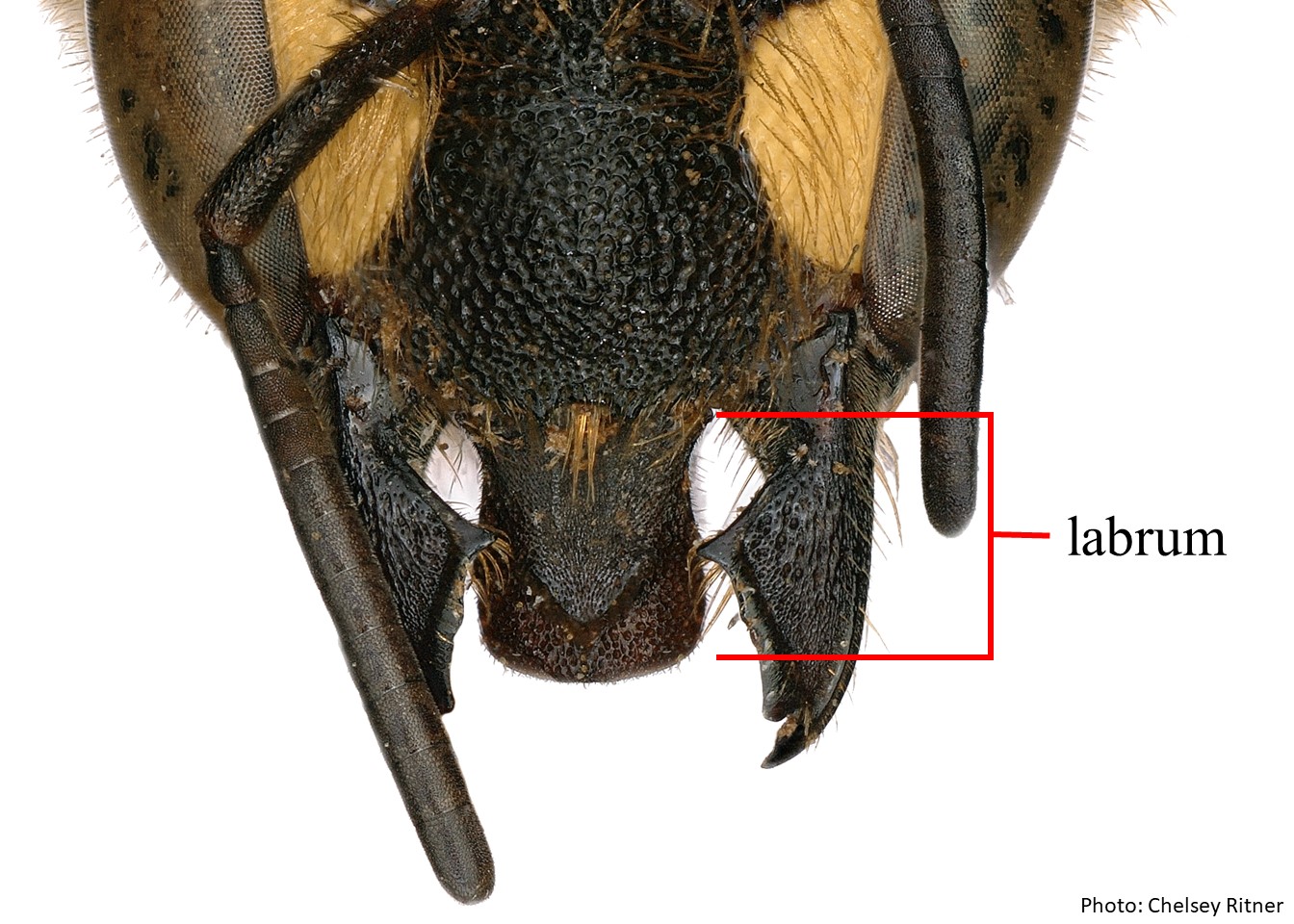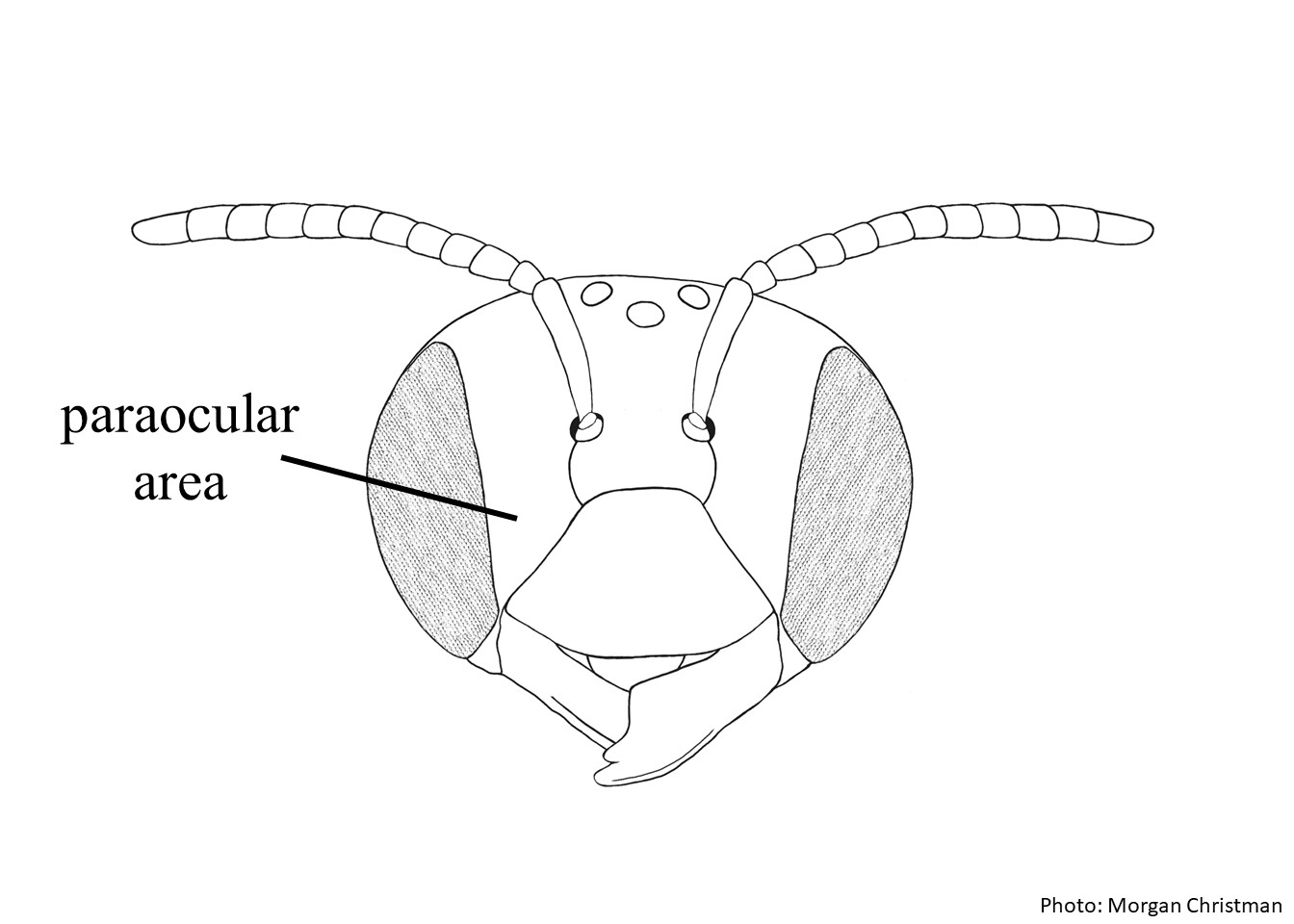Family: Megachilidae
Subfamily: Megachilinae
Tribe: Anthidiini
Genus: Anthidium Fabricius, 1804
Subgenus: A. (Anthidium) Fabricius, 1804
Species: Anthidium utahense Swenk, 1914
Common name: none
Anthidium (Anthidium) utahense are dark brown to black, with light brown coloration on the tarsitarsi:
the group of segments at the end of the leg following the tibia
, and yellow maculations (Gonzalez and Griswold 2013Gonzalez and Griswold 2013:
Gonzalez, V.H. and T.L. Griswold. 2013. Wool carder bees of the genus Anthidium in the Western Hemisphere (Hymenoptera: Megachilidae): diversity, host plant associations, phylogeny, and biogeography. Zoological Journal 168: 221ndash;425.). Females have white pubescencepubescence:
short, fine hair
except for some light ferruginousferruginous:
rust-colored
to yellow hairs on the vertexvertex:
the area between the ocelli and the back of the head, scutumscutum:
the large segment on top of the thorax located between the wings and behind the head
, axillaaxilla:
the triangular or rounded point on the thorax where thoracic muscles meet the forewing of an insect, scutellumscutellum:
shield shaped plate behind scutum, inner tarsitarsi:
the group of segments at the end of the leg following the tibia
, and occasionally S6S6:
the plates on the underside of the abdomen, often abbreviated when referring to a specific segment to S1, S2, S3, S4, S5, S6, S7, or S8
 . Females range in body length from 6.2–10.3 mm, and males range in length from 8.5–10.8 mm (Gonzalez and Griswold 2013Gonzalez and Griswold 2013:
. Females range in body length from 6.2–10.3 mm, and males range in length from 8.5–10.8 mm (Gonzalez and Griswold 2013Gonzalez and Griswold 2013:
Gonzalez, V.H. and T.L. Griswold. 2013. Wool carder bees of the genus Anthidium in the Western Hemisphere (Hymenoptera: Megachilidae): diversity, host plant associations, phylogeny, and biogeography. Zoological Journal 168: 221ndash;425.).
(modified from Gonzalez and Griswold 2013Gonzalez and Griswold 2013:
Gonzalez, V.H. and T.L. Griswold. 2013. Wool carder bees of the genus Anthidium in the Western Hemisphere (Hymenoptera: Megachilidae): diversity, host plant associations, phylogeny, and biogeography. Zoological Journal 168: 221ndash;425.)
 has two large preapicalpreapical:
has two large preapicalpreapical: has small but distinct laterallateral:
has small but distinct laterallateral: preapicalpreapical:
preapicalpreapical: median apicalapical:
median apicalapical: apicalapical:
apicalapical: with acute laterallateral:
with acute laterallateral: has a long, narrow, apicallyapically:
has a long, narrow, apicallyapically: laterallateral:
laterallateral: median spine.
median spine. laterallateral:
laterallateral:Anthidium utahense may be confused with A. jocosumbased on the small body size; female basitarsibasitarsi:
the segment of the tarsus that is the nearest to the body of the bee, usually the largest of all the tarsal segments lacking dense tomentum; shape of the female T6; and shape of male T7T7:
the segments on the top side of the abdomen, often abbreviated when referring to a specific segment to T1, T2, T3, T4, T5, T6, or T7 , genitaliagenitalia:
, genitaliagenitalia:
all the genital structures collectively
, and sternasterna:
the plates on the underside of the abdomen, often abbreviated when referring to a specific segment to S1, S2, S3, S4, S5, S6, S7, or S8
 (Gonzalez and Griswold 2013Gonzalez and Griswold 2013:
(Gonzalez and Griswold 2013Gonzalez and Griswold 2013:
Gonzalez, V.H. and T.L. Griswold. 2013. Wool carder bees of the genus Anthidium in the Western Hemisphere (Hymenoptera: Megachilidae): diversity, host plant associations, phylogeny, and biogeography. Zoological Journal 168: 221ndash;425.). Female A. utahense can be differentiated from A. jocosumby the broadly truncatetruncate:
ending abruptly, or squared off
apicalapical:
near or at the apex or end of any structure
margin T6T6:
the segments on the top side of the abdomen, often abbreviated when referring to a specific segment to T1, T2, T3, T4, T5, T6, or T7 and yellow maculations on the clypeusclypeus:
and yellow maculations on the clypeusclypeus:
a section of the face below the antennae, demarcated by the epistomal sutures and paraocular areaparaocular area:
the area extending along the sides of the face parallel to the eye
 (Gonzalez and Griswold 2013Gonzalez and Griswold 2013:
(Gonzalez and Griswold 2013Gonzalez and Griswold 2013:
Gonzalez, V.H. and T.L. Griswold. 2013. Wool carder bees of the genus Anthidium in the Western Hemisphere (Hymenoptera: Megachilidae): diversity, host plant associations, phylogeny, and biogeography. Zoological Journal 168: 221ndash;425.). Male A. utahense can also be differentiated from A. jocosumby the slightly more developed median apicalapical:
near or at the apex or end of any structure
brush on S4S4:
the plates on the underside of the abdomen, often abbreviated when referring to a specific segment to S1, S2, S3, S4, S5, S6, S7, or S8
 , and the more acute, dark, and sclerotizedsclerotized:
, and the more acute, dark, and sclerotizedsclerotized:
hardened by the formation of sclerotin, specifically the exoskeleton of an insect
laterallateral:
relating, pertaining, or attached to the side
lobe on S6S6:
the plates on the underside of the abdomen, often abbreviated when referring to a specific segment to S1, S2, S3, S4, S5, S6, S7, or S8
 (Gonzalez and Griswold 2013Gonzalez and Griswold 2013:
(Gonzalez and Griswold 2013Gonzalez and Griswold 2013:
Gonzalez, V.H. and T.L. Griswold. 2013. Wool carder bees of the genus Anthidium in the Western Hemisphere (Hymenoptera: Megachilidae): diversity, host plant associations, phylogeny, and biogeography. Zoological Journal 168: 221ndash;425.).
Anthidium utahense adults have been recorded in flight from March to mid-September; however, one specimen was recorded in October. Peak activity occurs from May to July (Gonzalez and Griswold 2013Gonzalez and Griswold 2013:
Gonzalez, V.H. and T.L. Griswold. 2013. Wool carder bees of the genus Anthidium in the Western Hemisphere (Hymenoptera: Megachilidae): diversity, host plant associations, phylogeny, and biogeography. Zoological Journal 168: 221ndash;425.).
Anthidium utahense is a generalist that has been observed visiting a variety of species within Alliaceae, Asteraceae, Boraginaceae, Brassicaceae, Cactaceae, Cleomaceae, Crassulaceae, Euphorbiaceae, Fabaceae, Fagaceae, Lamiaceae, Liliaceae, Malvaceae, Onagraceae, Plantaginaceae, Polemoniaceae, Polygonaceae, Portulacaceae, Rhamnaceae, Rosaceae, and Themidaceae (Gonzalez and Griswold 2013Gonzalez and Griswold 2013:
Gonzalez, V.H. and T.L. Griswold. 2013. Wool carder bees of the genus Anthidium in the Western Hemisphere (Hymenoptera: Megachilidae): diversity, host plant associations, phylogeny, and biogeography. Zoological Journal 168: 221ndash;425.).
Anthidium utahense nests in holes or crevices in the ground. Each nest has between one and four cells that are comprised of plant trichomes from Cirsium and Artemisia. Nest plugs are constructed with pebbles (Jaycox 1966Jaycox 1966:
Jaycox, E.R. 1966. Observations on Dioxys productus productus (Cresson) as a parasite of Anthidium utahense Swenk (Hymenoptera: Megachilidae). The Pan-Pacific Entomologist 42: 18ndash;20.).
Anthidium utahense occur west of the Rocky Mountains in the U.S. (Gonzalez and Griswold 2013Gonzalez and Griswold 2013:
Gonzalez, V.H. and T.L. Griswold. 2013. Wool carder bees of the genus Anthidium in the Western Hemisphere (Hymenoptera: Megachilidae): diversity, host plant associations, phylogeny, and biogeography. Zoological Journal 168: 221ndash;425.). In Mexico, they are found in Baja California. In Canada, they occur in southern British Columbia. They are found primarily in pine-oak forests, the Mojave and Sonoran deserts, California chaparral and woodlands, montane and coastal forests, shrub steppe, and grasslands. Anthidium utahense is very abundant in mediterranean California (Gonzalez and Griswold 2013Gonzalez and Griswold 2013:
Gonzalez, V.H. and T.L. Griswold. 2013. Wool carder bees of the genus Anthidium in the Western Hemisphere (Hymenoptera: Megachilidae): diversity, host plant associations, phylogeny, and biogeography. Zoological Journal 168: 221ndash;425.).
Distribution map generated by Discover Life -- click on map for details, credits, and terms of use.
Gonzalez, V.H. and T.L. Griswold. 2013. Wool carder bees of the genus Anthidium in the Western Hemisphere (Hymenoptera: Megachilidae): diversity, host plant associations, phylogeny, and biogeography. Zoological Journal of the Linnean Society 168: 221-425.
Jaycox, E.R. 1966. Observations on Dioxys productus productus (Cresson) as a parasite of Anthidium utahense Swenk (Hymenoptera: Megachilidae). The Pan-Pacific Entomologist 42: 18-20.